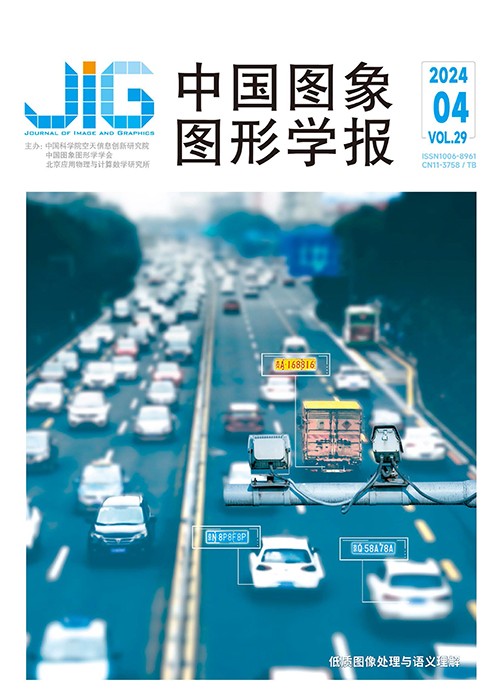
图像去模糊研究综述
摘 要
图像模糊是指在图像捕捉或传输过程中,由于镜头或相机运动、光照条件等因素导致图像失去清晰度和细节,从而影响图像的质量和可用性。为了消除这种影响,图像去模糊技术应运而生。其目的在于通过构建计算机数学模型来衡量图像的模糊信息,从而自动预测去模糊后的清晰图像。图像去模糊算法的研究发展不仅为计算机视觉领域的其他任务提供了便利,同时也为生活领域提供了便捷和保障,如安全监控等。1)回顾了整个图像去模糊领域的发展历程,对盲图像去模糊和非盲图像去模糊中具有影响力的算法进行论述和分析。2)讨论了图像模糊的常见原因以及去模糊图像的质量评价方法。3)全面阐述了传统方法和基于深度学习方法的基本思想,并针对图像非盲去模糊和图像盲去模糊两方面的一些文献进行了综述。其中,基于深度学习的方法包括基于卷积神经网络、基于循环神经网络、基于生成式对抗网络和基于Transformer的方法等。4)简要介绍了图像去模糊领域的常用数据集并比较分析了一些代表性图像去模糊算法的性能。5)探讨了图像去模糊领域所面临的挑战,并对未来的研究方法进行了展望。
关键词
Survey of image deblurring
Hu Zhangying1, Zhou Quan1, Chen Mingju2, Cui Jingcheng1, Wu Xiaofu1, Zheng Baoyu1(1.School of Communication and Information Engineering, Nanjing University of Posts and Telecommunications, Nanjing 210003, China;2.Artificial Intelligence of Key Laboratory of Sichuan Province, Sichuan University of Science and Engineering, Yibin 644000, China) Abstract
Image blurring refers to the loss of clarity and detail in an image during its capture or transmission due to factors such as motion of the lens or camera,lighting conditions,and other environmental variables.This loss of quality and usability can significantly influence the overall visual impact of the image.The technique of image deblurring has been developed to mitigate such effects.Its purpose is to predict the clear version of an image automatically by constructing computer mathematical models that measure the blurriness of the image.The research and development of image deblurring algorithms have not only provided convenience for other tasks in the field of computer vision,such as object detection,but have also offered assurance in various aspects of life,including security monitoring.Depending on its cause,blurring can mainly be divided into motion blur,out-of-focus blur,and Gaussian blur.Out-of-focus and Gaussian blurs are less prevalent and relatively easier to handle,whereas motion blur is more likely to occur in situations such as road traffic cameras,pedestrian movement,and fast-moving vehicles,making it a more critical issue to be addressed.After an image is deblurred,evaluating the quality of the results becomes essential,which is carried out using methods for image quality assessment(IQA),categorized as either subjective or objective.Objective evaluation methods can be divided into three types:full-reference,reduced reference,and no reference.Owing to constraints in resources,objective evaluation methods make up the majority of IQA approaches.The process of image blurring can be represented as the convolution of a clear image with a blur kernel,accompanied with greater or lesser degrees of noise.Therefore,image deblurring comprises two types:non-blind image deblurring(NBID)and blind image deblurring(BID).Non-blind deblurring involves the restoration of an image with a known blur kernel,requiring prior knowledge of the blur kernel' s parameters.On the contrary,blind deblurring aims to restore images with unknown blur kernels or unknown clear images,posing a more challenging problem to solve because of the increased number of unknown factors.In light of these considerations,we systematically and critically review the recent advancements in image deblurring.A comprehensive and systematic introduction of image deblurring is presented from the following two aspects:1)the evolution of traditional image deblurring and 2)the development of deep learning-based image deblurring.From the perspective of traditional image deblurring,the existing image deblurring methods can be divided into two categories:non-blind deblurring and blind deblurring.Specifically,traditional NBID algorithms rely on prior knowledge of the blur kernel for the restoration process.Common methods include denoisingand iteration-based methods.Traditional BID methods primarily involve estimating the blur kernel first and transforming it into an NBID problem afterward.The kernel and clear image are often estimated iteratively until satisfactory results are obtained.The emerging deep learning methods extract blur image features through training a neural network and employing logistic regression to update models.Unlike traditional methods that require prior knowledge of the degree of image blur,deep learning-based methods are capable of directly processing blurry images without the need for prior estimation of the blur degree.From the perspective of network architecture,deep learning-based image deblurring algorithms can be classified into convolutional neural network(CNN)-based,recurrent neural network(RNN)-based,generative adversarial network(GAN)-based,and Transformer-based networks.CNN-based methods can learn the mapping between blurry and clear images by training on a large number of image pairs,which enables them to perform blind deblurring.These algorithms take advantage of parameter sharing and local receptive fields,reducing the number of model parameters and improving the accuracy of image feature extraction.Image deblurring based on RNN is a type of neural network model that can handle sequential data through learning the relationship between sequential data.GAN-based deblurring approaches define image deblurring problems as an adversarial game between generators and discriminators.Transformer-based methods employ a self-attention mechanism to encode global dependencies between different spatial positions,thereby capturing the global information of an entire image.Our critical review focuses on the main concepts and discussions of the characteristics of each method for image deblurring from the perspective of network architecture.Particularly,we summarize the limitations of different deblurring algorithms.We also briefly introduce popular public datasets.Then,we review some image deblurring literature from two aspects:traditional methods and deep learning-based methods.The capability of representative algorithms is analyzed using peak signal-to-noise ratio and structural similarity evaluation indexes in terms of GoPro Labs,human-aware motion deblurring,and other datasets.Furthermore,this review critically analyzes the conclusion,highlighting the challenges in image deblurring.
Keywords
image deblurring convolutional neural network(CNN) recurrent neural network(RNN) generative adversarial network(GAN) Transformer deep learning
|



 中国图象图形学报 │ 京ICP备05080539号-4 │ 本系统由
中国图象图形学报 │ 京ICP备05080539号-4 │ 本系统由